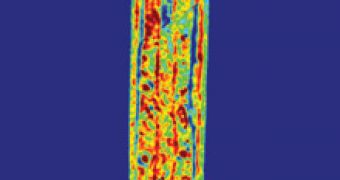Now, porn really can go down to a very low level. Scripts can include sperm cells and eggs or bacteria if you want.
A MIT team has designed a microscope that acts like a camera generating three-dimensional movies of live cells. The device functions like a cellular CT scanner, giving researchers the opportunity to see how cells really behave in real time. The new technique is more than a combination between resolution and live action, enabling us to see live cells in action and screen drugs.
A traditional microscope cannot reveal cells as they absorb very little of the visible light; that's why the MIT team relied on how they refract light (the way they change direction and wavelength of light passing through them).
Various parts of the cell refract light in different ways and the new device detects these details.
"Other methods for creating three-dimensional images of cells only allow researchers to look at "controlled artifacts." To be viewed using a conventional microscope cells have to be treated with fixing agents and stains, and are dead; what's visible in these images is not really what a cell looks like." said lead researcher Michael Feld, a MIT professor of physics.
"Our technique allows you to study cells in their native state with no preparation at all. It can, for example, capture chromosomes spooling during cell division or a cervical cancer cell shriveling up when treated with acetic acid."
The device forms 3-D images by mixing pictures of a cell taken from various angles. In only 0.1 seconds a new 3-D image is formed, quick enough to see a cell reaction in real time. A similar process, named tomography, is employed in CT scans, which use X-ray images taken from various angles to make 3-D images of the body, but the MIT microscope operates at a much smaller scale.
The team has got by now images of single cells, like cervical cancer cells and of very small nematod worms, from the species C. elegans, of only 1 mm long and with a body of approximately 1,000 cells.
"The microscope cannot currently image anything much bigger than this because thicker tissues containing a large number of cells scatter light, creating a "foggy" image. Future versions of the microscope might overcome this limitation by emitting and detecting light from a single location; the current microscope shines light on one side of the sample and collects it on the other." said Feld.
"You can capture cells in their natural environment and see how they respond to changes. Otherwise you just get a snapshot in time of a cell." said Maryann Fitzmaurice, associate professor of pathology at Case Western Reserve University. "Because the technique is so new, it's not clear what researchers will learn about cells by looking at refraction images. It's a very basic technique, with a lot of potential uses," she says.
One application is already forecast: drug screening in live cells. The microscope would reveal the cells' response. The device has already been employed in one case. While performing pelvic examinations, doctors can apply acetic acid to the cervix, making pre-cancerous tissues turn white.
"Doctors have known that this works, but not why. Using the MIT microscope, researchers were able to clearly see the changes in different parts of the cell, which is very valuable in understanding this test" said Fitzmaurice.

 14 DAY TRIAL //
14 DAY TRIAL //